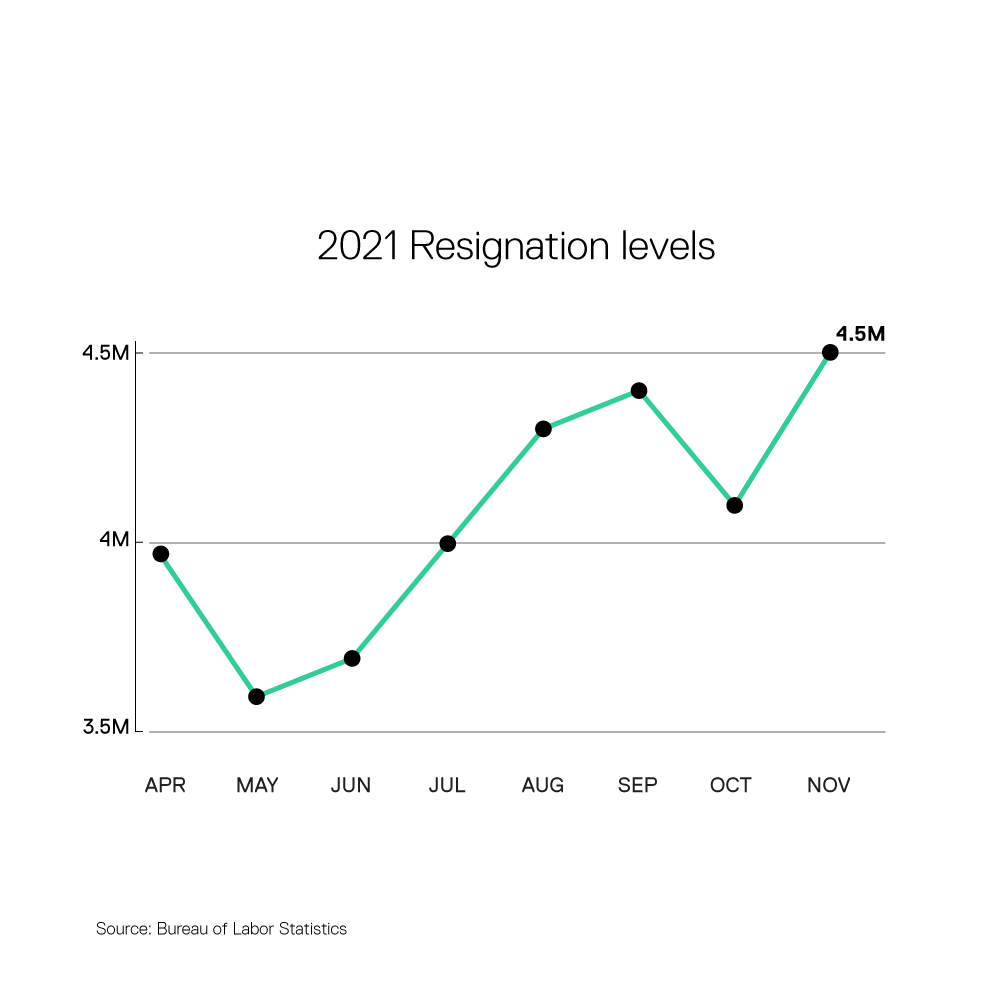AOP
How to Counter the Great Resignation Wave
In an unpredictable economy, no employer expects mass resignations from their staff. Surprisingly, this is exactly what has taken place since the onset of the COVID-19 pandemic. Dubbed the Great Resignation, businesses are scrambling to understand why employee retention may be the next big issue they face. We explore its causes and possible remedies below.

Jump to section
What is the Great Resignation?
What lies behind it?
How can companies combat the Great Resignation?
—
Developments in the world at large regularly produce new trends and behaviors throughout the business landscape. New jobs are created based on novel demands from the market, working methods are adapted due to available tech and talent, and shifting societal attitudes affect the prevalence of characteristics in the professional environment (think dogs in the office, mental health days, and company-subsidized child care).
Without a doubt, the largest recent event to have triggered radical corporate change is the COVID-19 pandemic. Working from home, mask-wearing in communal areas, and touching elbows instead of shaking hands are just a few of the behavioral alterations implemented to ensure safe, as well as efficient, business practice.
Although some COVID-influenced changes are instantly perceptible, others have taken a while to develop. For instance, there is still uncertainty regarding the recovery of some industries, such as travel and hospitality, and we are not yet sure how vaccination status may affect employees in a range of positions.
One of the most recently recognized trends, however, is also one of the most surprising. Despite the pandemic producing high levels of instability in numerous sectors, 2021 showed a clear but unexpected pattern in employee behavior; increasing numbers of the workforce began handing in their resignations.
Having started among young employees in late 2020, the last 18 months have seen workers quit their roles in record-breaking numbers. As this pattern and its effects become more pronounced, business leaders are scrambling to understand this new phenomenon.
In these uncertain times, why are so many of the workforce electing to leave stable employment, and what can businesses do to retain employees?
What is the Great Resignation?
Coined by Professor Anthony Klotz, at Texas A&M University, the Great Resignation describes the recent phenomenon of employees voluntarily quitting their jobs en masse. In 2021, the number of US workers handing in their notices continuously broke records over four separate months. Peaking in November with 4.5 million vacating their roles, this figure is the highest “quit rate” witnessed since the Department of Labor began tracking numbers in 2001.

And this pattern is not limited to the USA, with similar trends visible across the globe. A report released in June 2021 revealed how almost 50% of Dutch employees confessed to wanting to find a new job in the next year. Furthermore, in July 2021, more than one-third of German companies reported staff shortages, the highest rate in the last three years, whilst in Vietnam workers are reluctant to return to the factory floor.
This pattern is so widespread that recent research from Microsoft revealed how 41% of the global workforce will consider leaving their employer in the next 12 months, whilst 46% are planning a major pivot or career transition.
The trend of employees resigning has been most visible in 2021, but the stats above indicate it may continue for some time yet. As the Great Resignation gains momentum, employers are starting to pay closer attention, with the need to understand its driving factors and how to combat these is growing ever more urgent.
What lies behind the Great Resignation?
Quite simply, the pandemic appears to be the catalyst for the majority of workers upping sticks over the past 12-18 months. But with unpredictability and uncertainty caused by COVID, it’s unclear why this would be the case. Why would an employee jeopardize a stable income during one of the most turbulent times in modern history?
More time to reflect
For various reasons, including furlough schemes, reduced working hours, and no longer undertaking a daily commute, employees found themselves with more free time. In some cases Klots theorizes this led to a “Pandemic Epiphany”, where workers used this additional time to reflect on their lives and reevaluate their careers. Had they grown bored of their current role? Were their careers developing as expected? Were they even happy?
The unpredictability of the pandemic, although causing some of the workforce to cling to their current positions, reminded others that life itself is unpredictable. Some concluded it was better to roll with the punches doing a job they’d love than slog it out in the safety offered by a humdrum career.
Remote work opportunities
As working from home became mandatory for many employees, opportunities arose in positions that would have previously been off-limits due to location. Job seekers could apply for positions in organizations much farther afield than had previously been available, offering a range of new opportunities.
Remote work also inspired those who had grown tired of city life to up sticks and move elsewhere, generally to somewhere more suburban and quiet. When confusing or tiresome back-to-office policies were introduced, some of those who handed in notices did so because they prioritized this newfound lifestyle over city living.
Remote working also allowed access to new careers which could be pursued from the comfort of home. Online trading and investment, for example, became more popular during this time, partly due to canceled sporting events, leaving those who fancied a wager looking for a similar outlet.
Concluding their company didn’t care
For various reasons pre-pandemic, many employees had requested but been denied the opportunity to work from home. Prior to widespread lockdowns, organizations estimated it would take 454 days to effectively implement telecommuting. Once it became a necessity, most required only 11 days to get this up and running. Although finally giving some staff a perk they had previously asked for, this corporate quick change of heart proved only one thing: employee requests didn’t matter. The company would always put its own interests first. This, and other examples exacerbated by the pandemic, was enough of a wake-up call for some to seek out new opportunities.
For employees who didn’t have the possibility of working from home, such as essential staff in supermarkets, the pandemic offered realization that their health and safety came second to company profits. Constantly working on the frontline, often in teams reduced in size due to illness amongst staff, some of this cohort took the opportunity to find an employer they felt showed higher levels of appreciation.
Rise of burnout

In the last 18 months, burnout was at an all-time high and is often cited as the largest contributor to the Great Resignation. With working from home compulsory, the blurring of work and professional boundaries further eroded, causing an inability to fully switch off.
The way in which remote work is undertaken also took its toll. “Zoom fatigue” increased as business meetings and practically all socializing took place via video conferencing. A lack of familiar rituals which usually help individuals mentally digest their day, such as daily commutes or walking to the next meeting, also contributed to cognitive overload.
Gained autonomy through self-employment
Particularly as other freedoms were restricted, the pandemic presented the value of professional autonomy to many employees. Working from home offered a greater sense of independence which some yearned to retain or build on. Gone were many of the small irritations of office life and some employees began working more flexibly at various times throughout the day.
Some workers decided to take this further and utilized the pandemic as an opportunity to become their own boss. As well as turning to freelancing, which more than a third of the US workforce at least dabbled in during the pandemic, 2020 saw an explosion in new business applications. In the US these peaked close to 4.5 million, nearly a 25% increase from 2019.
How can companies combat the Great Resignation?
Offer flexibility

Although some of the points above may seem contradictory (employees like working from home but become overwhelmed if they too frequently have to use Zoom) there is a sweet spot that can be found to keep employees happy. That sweet spot is reached by offering flexibility.
A recent global workforce study revealed that 89% of workers now expect remote working to be incorporated into their roles as the norm. However, only a quarter of these employees wanted to work remotely full-time, with the majority opting for a mix of days in the office and telecommuting. As a result, 66% of businesses are already contemplating redesigning physical office spaces to facilitate hybrid work practices.
This is a great move for any organization to consider, as evidence suggests that working from home increases employees’ effort, productivity, and sense of autonomy, particularly when paired with flexible work arrangements.
And it’s these flexible work arrangements that are most prioritized among the workforce today. In the wake of the pandemic, 56% of US workers requested flexibility above all other factors – including higher pay (53%) and job security (47%) – when asked what they want from their careers. Consider how your workplace can offer flexibility and autonomy to your employees to ensure they are retained.
Offer support
Pre-pandemic, burnout was already causing staff to quit, and understaffing from the Great Resignation may only make it more likely that staff remaining in their roles feel increased stress. Offering adequate support during this time is essential to ensure workers don’t look elsewhere.
Consider implementing regular feedback processes to ensure employees feel heard. Introduce frequent surveys, polls, and one-to-one sessions with team leaders, but keep in mind that these sessions aren’t just about listening. The information gained must truly be considered and, if appropriate, acted upon in order to show employees their feedback is listened to and important.
Well-being initiatives can also be rolled out among staff to promote employee welfare; mental health resources, blocked calendar times for focused work, and support groups to allow employees to come together and air grievances are all effective ways of strengthening staff well-being.
It’s also important to remember that employees often desire growth within the organization they work for, something which 43% of the workforce felt stalled during the pandemic. Ensure opportunities for career development are available and regular discussions take place.
Provide resources through platforms like Spyker
Support can also come in the form of resources that ensure employees are able to carry out work effectively. Frustrations through inadequate tools and software lower productivity and increase the likelihood of burnout, which, as we have seen, is the largest contributor towards the Great Resignation.
Products such as Spyker’s App Composition Platform offer efficiency and simplicity among multiple teams. Spryker’s App Composition Platform allows Spryker customers direct access to a range of third-party applications covering a diverse array of uses, such as new payment platform integrations and AI-powered site optimizations. Implementation of these apps, including a fully functioning trial period, is quick and easy, reducing the workload of several teams whilst helping your business efficiently reach its goals.
–
The Great Resignation may not have been an expected outcome from the COVID pandemic, but it’s one that many organizations are finding increasingly difficult to ignore. Lockdowns may have thrown aspects of business practice into a tailspin, but led great swathes of the workforce to more clearly understand what it is they really seek from their employment. Organizations which do not heed or understand the wants and desires of staff in a world so incredibly altered do so at their own peril.
Want to learn more about how Spryker can help support your staff during this turbulent time? Contact our sales team for further information!